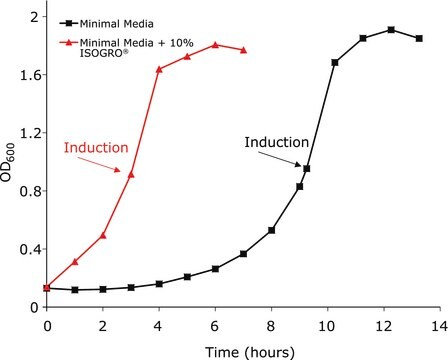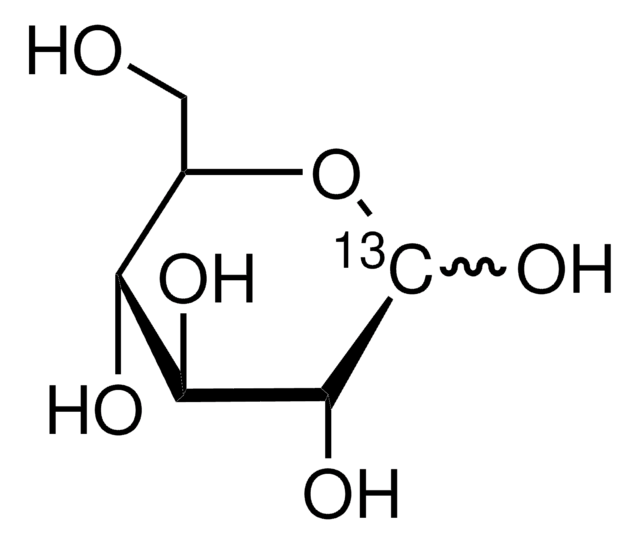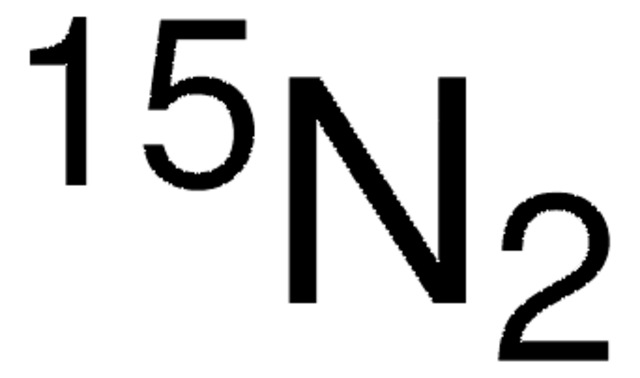606871
ISOGRO®-15N Powder -Growth Medium
98 atom % 15N
Autenticatiper visualizzare i prezzi riservati alla tua organizzazione & contrattuali
About This Item
Prodotti consigliati
Purezza isotopica
98 atom % 15N
Livello qualitativo
tecniche
bio NMR: suitable
protein expression: suitable
Temperatura di conservazione
−20°C
Categorie correlate
Applicazioni
ISOGRO®-15N Powder -Growth Medium has been used:
- for the production of 15N histone H2A for nuclear magnetic resonance (NMR) spectroscopy studies.
- for the production of 15N-enriched protein kinase C and H3 histone for NMR studies.
Confezionamento
This product may be available from bulk stock and can be packaged on demand. For information on pricing, availability and packaging, please contact Stable Isotopes Customer Service.
Note legali
ISOGRO is a registered trademark of Merck KGaA, Darmstadt, Germany
Codice della classe di stoccaggio
13 - Non Combustible Solids
Classe di pericolosità dell'acqua (WGK)
WGK 1
Punto d’infiammabilità (°F)
Not applicable
Punto d’infiammabilità (°C)
Not applicable
Scegli una delle versioni più recenti:
Possiedi già questo prodotto?
I documenti relativi ai prodotti acquistati recentemente sono disponibili nell’Archivio dei documenti.
I clienti hanno visto anche
Expression and purification of the N-terminal regulatory domain of protein kinase C for biophysical studies
Cole TR and Igumenova TI
Protein Expression and Purification, 110(4), 14-21 (2015)
Mechanisms of ubiquitin-nucleosome recognition and regulation of 53BP1 chromatin recruitment by RNF168/169 and RAD18
Hu Q, et al.
Molecular Cell, 66(4), 473-487 (2017)
Carissa L Perez et al.
Cell metabolism, 8(3), 266-274 (2008-09-03)
Although studies in C. elegans have identified numerous genes involved in fat storage, the next step is to determine how these factors actually affect in vivo lipid metabolism. We have developed a (13)C isotope assay to quantify the contribution of
Xavier Hanoulle et al.
The Journal of biological chemistry, 282(47), 34148-34158 (2007-09-15)
The chemotaxis and integrin-mediated adhesion of T lymphocytes triggered by secreted cyclophilin B (CypB) depend on interactions with both cell surface heparan sulfate proteoglycans (HSPG) and the extracellular domain of the CD147 membrane receptor. Here, we use NMR spectroscopy to
Weizhi Liu et al.
The Journal of biological chemistry, 284(45), 31336-31349 (2009-08-28)
The eukaryotic translation initiation factor eIF4E recognizes the mRNA cap, a key step in translation initiation. Here we have characterized eIF4E from the human parasite Schistosoma mansoni. Schistosome mRNAs have either the typical monomethylguanosine (m(7)G) or a trimethylguanosine (m(2,2,7)G) cap
Il team dei nostri ricercatori vanta grande esperienza in tutte le aree della ricerca quali Life Science, scienza dei materiali, sintesi chimica, cromatografia, discipline analitiche, ecc..
Contatta l'Assistenza Tecnica.







